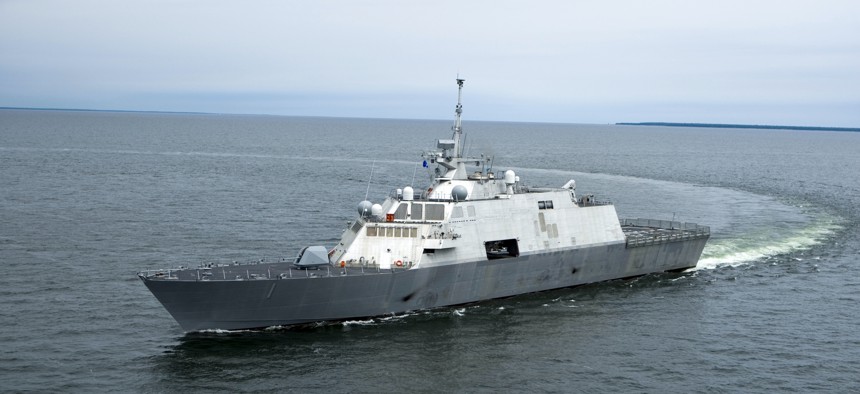
The first U.S. Navy Littoral Combat Ship, Freedom, is seen underway during trials in July 2008. U.S. Navy
Navy Leaders Defend Plan To Cut the Fleet Amid GOP Criticism
“We think at this point we’re throwing good money after bad,” Chief of Naval Operations Adm. Michael Gilday told the House Armed Services Committee.
Navy leaders on Wednesday defended their decision to cut the fleet, rebutting Republicans’ claims that the fiscal 2023 budget proposal will make the Navy weaker against adversaries like China.
Chief of Naval Operations Adm. Michael Gilday told the House Armed Service Committee that the money saved by decommissioning ships that are not adding to the Navy’s capabilities will go toward other priorities like increasing readiness or modernizing platforms to compete in a high-end technologically advanced conflict.
“While building capacity at the expense of readiness and modernization can sound like an attractive proposition, it is not one that I endorse,” Gilday testified. “We have been there before and we have seen tragic results. I refuse to repeat it again.”
The Navy’s 2023 request released in March seeks to decommission 24 ships, 16 of which still have remaining service life. The list includes nine Freedom-class littoral combat ships, five Ticonderoga-class cruisers, two Los Angeles-class submarines, four landing dock ships, two oilers, and two expeditionary transfer docks. If Congress allows the Navy to scrap them all, the service will save $3.6 billion over the next five years.
Rep. Mike Rogers, R-Ala., the ranking member of the House Armed Services Committee, slammed the plan and criticized service leaders for working within a budget he believes is too small instead of being transparent with Congress about what the Navy needs, even if it surpasses the funding set by the Pentagon.
“Does the retirement of 24 ships in fiscal year 2023 and the accelerated reduction of 10 percent of our fleet’s conventional strike capability in the next five years make our conventional deterrent stronger or weaker?” Rogers asked Gilday.
“I don’t think it puts us in a better place, sir; however, it’s not just about numbers,” Gilday replied. “Could we always use more? Absolutely….but we are fielding a highly lethal capable force.”
The number of ships in the Navy is a frequent political talking point. The Trump administration promised to build a 350-ship Navy, larger than the nearly 300 ships the service has today. But improved technology that boosts the capability of ships far beyond their predecessors and the rise of unmanned underwater platforms have raised questions about what the right number really is. Gilday said in February that the Navy needs more than 500 ships, but 150 of those would be unmanned.
In coming up with the 2023 plan, Gilday said leaders evaluated whether sailors could count on a ship to have the reliability and lethal power to “actually move the needle” in a conflict with a near-peer threat like China.
The cruisers the Navy wants to decommission, for example, are not reliable and not technologically able to compete in today’s threat environment, Gilday said. The spy radars on the ships are so out of date that they “can’t see the threat, so if they can’t see it, they can’t shoot it down,” he said. Three cruisers also had to pause recent deployments and return to ports to repair leaks below the waterline or in the fuel tanks.
“We think at this point we’re throwing good money after bad,” Gilday said. “The money that we save from those cruisers gets reinvested into readiness, into modernization, and into capacity.”
The Navy wants to retire the nine littoral combat ships because an anti-submarine warfare system that enabled the main function of the ship “did not work out technically, Gilday said.
“After a year-and-a-half study, I refuse to put an additional dollar against a system that could not track a submarine in today’s environment,” he said.
Some Democrats, including Rep. Adam Smith, D-Wash., who chairs the committee, commended the Navy for proposing to cut ships that do not contribute anything to the fleet.
“It’s easy to say, ‘My gosh, why would you get rid of 10 ships? They’re sitting here, why can’t we use them?’” Smith said. “A lot of times they’re not ready to do anything…and when they are, they still break down. They’re incredibly expensive, and they don’t have the capabilities we expect. So regardless of how old they are, that’s a lot of money to be spent to get pretty close to nothing.”




